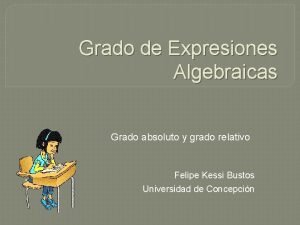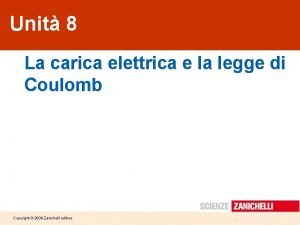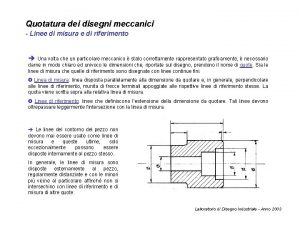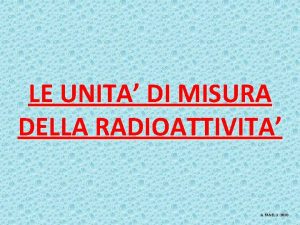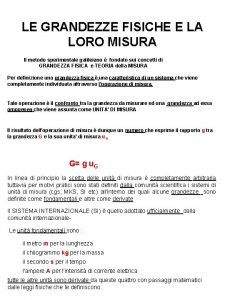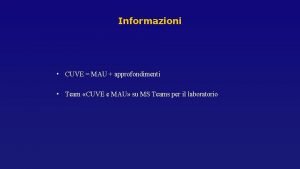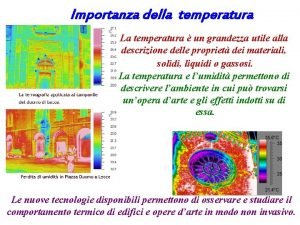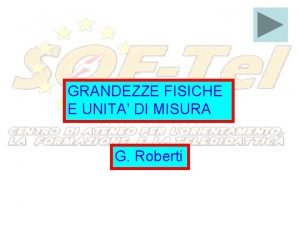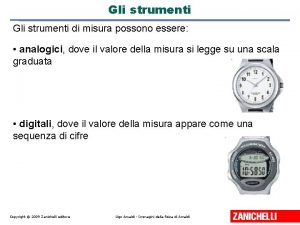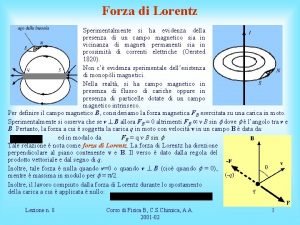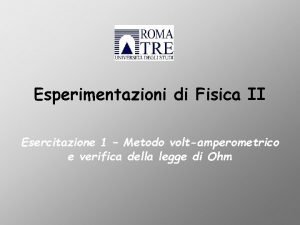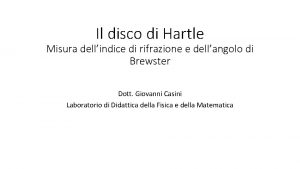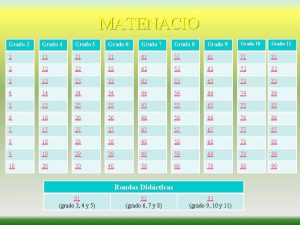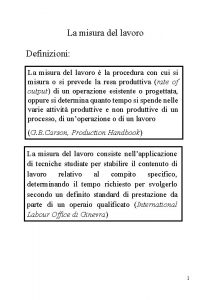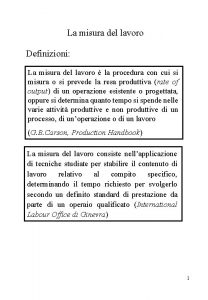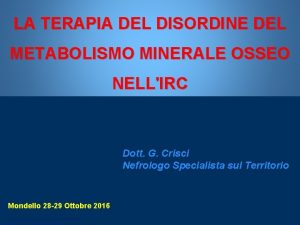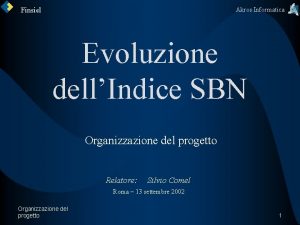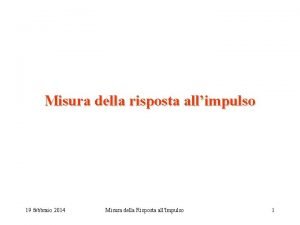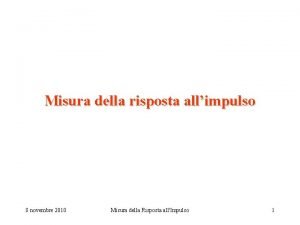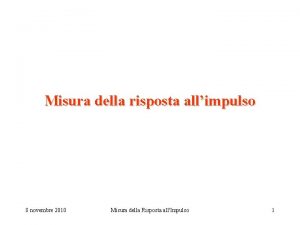Misura del grado di disordine e dellindice di














- Slides: 14

Misura del grado di disordine e dell’indice di frattalità mediante tecniche NMR di diffusione anomala Silvia Capuani*, Marco Palombo°, Alessandra Caporale*, Andrea Gabrielli* *CNR-IPCF UOS Roma Physics Dpt. “Sapienza” Univ, Rome, Italy °MIRcen, I 2 BM, Commissariat à l'Énergie Atomique, CNRS, Fontaney-aux-Roses, Paris, France silvia. capuani@roma 1. infn. it 101° Congresso della SIF. Roma, 21 -25 settembre 2015

Non-ordinary diffusion: anomalous diffusion In disordered and complex systems and highly heterogeneous media, diffusion is often non-Gaussian or anomalous And many other examples. . .

CTRW approach (l) = pdf of jumps lenght l <x 2> w(t) = pdf of waiting time t, between two consecutive jumps If <l 2>, <t> < Gaussian diffusion, ordinary diffusion equation: <x 2(t)> t If <l 2> < , <t> = Anomalous sub-diffusion, time fractional derivative equation: <x 2(t)> t , with 0< <1 If <l 2> = , <t> < Anomalous super-diffusion, space fractional derivative equation: <x 2(t)> t 1/ , with 0< <1 Metzler R. , Klafter J. , Phys. Rep. 339 (2000)

Why and How to measure diffusion by NMR By using radio-frequency and magnetic field gradient pulses. Pulse Gradient Spin Echo (PGSE) sequence. : varying PGSE The PGSE signal is proportional to the characteristic function of the diffusion propagator in time

Anomalous diffusion in 3 D porous media: experiments Biophysical interpretation of and parameters Length scale(s) of magnetic heterogeneity Disorder Degree Palombo M. , Gabrielli A. , De Santis S. , Cametti C. , Ruocco G. , Capuani S. , J. Chem. Phys. 135 (2011)

Anomalous diffusion in 3 D porous media Analysis of sub-diffusion processes and disorder degree in crowded media Φ = 0. 74 Q = 1 Bond-orientational order parameters Φ = 0. 737 Q = 0. 70 Φ = 0. 670 Q = 0. 65 Q = Q 6 system/Q 6 fcc Spatial distribution of obstacles Sphere packing Steinhardt P. J. , Nelson D. R. , Ronchetti M. , Phys. Rev. B 28 (1983)

Anomalous diffusion in 3 D porous media: simulations Φ = 0. 74 Φ = 0. 68 Φ = 0. 64 Q fcc =1 Occupied volume Free volume random config. Occupied volume <1 Free volume Palombo M. , Gabrielli A. , Servedio V. D. P. , Ruocco G. , Capuani S. , Scientific Report, 3 (2013)

Anomalous diffusion in 3 D porous media: NMR experiments From geometrical structure characterization to anomalous diffusion properties: comparison of Monte Carlo simulation results to d. NMR experimental data Palombo M. , Gabrielli A. , Servedio V. D. P. , Ruocco G. , Capuani S. , Scientific Report, 3 (2013)

Application to multiscale porous materials Highly porous polymeric matrices with randomly oriented interconnected pores obtained from a solution of polyvinyl alcohol and etyltrimethylammonium bromide (PVA scaffolds) • void size distribution: 10 -100 m • interconnection size distribution: 4 -50 m • the three scaffolds differ in the roughness of the walls of their voids and interconnections PVA 1 PVA 2 PVA 3 PVA 2 PVA 1 Barbetta A. et al. , Soft Matter, 6 (2010) PVA 3

Gaussian approach Imaging: PGSTE sequence TR = (5000 - ) ms TE = 15 ms; = 2 ms g = 74 m. T/m = (20 520) ms SA= 45 m 2/g PVA 1 PVA 2 PVA 3 SA= 68 m 2/g SA= 106 m 2/g PVA 1 PVA 3 PVA 2 3 Palombo M. , Barbetta A. , Cametti C. , Dentini M. , Capuani S. , in preparation

Anomalous diffusion approach Imaging: PGSTE sequence TR = (5000 - ) ms TE = 15 ms; = 2 ms g = 74 m. T/m = (20 520) ms SA= 45 m 2/g PVA 1 PVA 2 PVA 3 SA= 68 m 2/g SA= 106 m 2/g PVA 1 PVA 3 PVA 2 3 Palombo M. , Barbetta A. , Cametti C. , Dentini M. , Capuani S. , in preparation

Application to multiscale porous materials fractal dimension M. J. Saxton Biophys, J. 66 (1994) X=S/ Palombo M. , Barbetta A. , Cametti C. , Dentini M. , Capuani S. , in preparation

Conclusions • ( which quantifies subdiffusion processes) can be measured by non invasive and non destructives diffusion NMR techniques. • , is affected by both the density (Φ) and the spatial distribution (Q) of obstacles: = (Q, Φ) • value quantifies global structural complexity. It enables a classification of different kinds of disorder and it allows to monitor structural transitions. • Our results indicate that , which quantifies the crowding effect on diffusion process, can be used to measure the fractal dimension of the random path (dw): = 2/dw • MAPS dramatically submicrostructures increase NMR sensitivity to micro and • The present work suggests that may be used to quantify unresolved effects due to heterogeneities and disorder in soft materials and living tissues.

Thank you for your attention NMR Laboratory, CNR-ISC Physics Dpt. Sapienza University of Rome, Italy silvia. capuani@roma 1. infn. it
 Grado absoluto de un polinomio ejercicios resueltos
Grado absoluto de un polinomio ejercicios resueltos Strumenti di misurazione del tempo
Strumenti di misurazione del tempo Conduttori e isolanti zanichelli
Conduttori e isolanti zanichelli Uda l'energia e le sue trasformazioni
Uda l'energia e le sue trasformazioni Da sessadecimale a centesimale
Da sessadecimale a centesimale Albero quotato
Albero quotato Accelerometro misura vibrazioni
Accelerometro misura vibrazioni Gy unità di misura
Gy unità di misura Fai degli esempi di misura diretta e indiretta
Fai degli esempi di misura diretta e indiretta Mau unità di misura
Mau unità di misura Importanza della temperatura
Importanza della temperatura 10 cm3 di acqua hanno una massa praticamente uguale a
10 cm3 di acqua hanno una massa praticamente uguale a Errori di misura zanichelli
Errori di misura zanichelli Unità di misura forza di lorentz
Unità di misura forza di lorentz Misura voltamperometrica
Misura voltamperometrica
